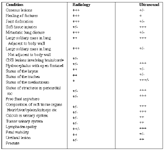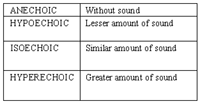Radiography vs. ultrasonography: Which one to use to make the diagnosis (Proceedings)
You'll need one opacity surrounding something of a different opacity to be able to define it radiographically.
Indications for Radiographic Examination
• Overview
• Size, shape, position, contour, opacity
• Very good for bone and gas-skeletal system, lungs
• Contrast studies-GI series, IVU, cystourethrogram, vaginogram enhance ability to define structures.
• Can only see four opacities-gas, fat, bone and "soft tissues"
• Need one opacity surrounding something of a different opacity to be able to define it radiographically
Indications for Ultrasound Examination
• Individual soft tissue organ composition
• Dynamic blood flow
• Not so good for bone and gas

Indications
Abdominal Cavity
A) Method Of Choice For Detecting Etiology For Peritoneal Fluid.
1. Fluid Acts As "Acoustic Window/Contrast Medium" Which Help Visualization Of Intra-Abdominal Structures.
2. Abdominal Masses Can Be Assessed Despite The Presence Of Hemorrhage.
B) Liver Can Be Evaluated, Espeically Its Architecture And Contour.
1. Focal Lesions-Metastasis, Nodular Hyperplasia.
2. Mass Lesions-Abscess, Cysts, Neoplasia
3. Hepatic Congestion
4. Vascular Abnormalities-Shunts, Av Fistula
5. Cirrhosis
C) Hepatobiliary System-Indicated In Presence Of Jaundice
1. Cholelithiasis
2. Extra-Hepatic Biliary Obstruction, Enlarged Common Bile Duct
3. Enlargement Of Intrahepatic Bile Ducts
4. Neoplasia Involving Biliary System
5. Obstruction Due To Pancreatic Disease
D) Spleen-Indicated In Presence Of Splenomegaly And Blood Dyscrasias
1. Torsion
2. Neoplasia
3. Nodular Hyperplasia
4. Infection
5. Infarction
6. Hematoma
E) Urogenital System
1. Pregnancy Diagnosis 10-25 Days Post-Breeding
2. Fetal Viability
3. Ovarian Masses, Cysts
4. Infertility
5. Pyometra/Hematometra
6. Ovarian Pedicle And Uterine Stump Pyogranuloma
7. Scrotal Enlargement-Neoplasia, Hydrocele
8. Location Of Retained Testicle
9. Prostate Gland-Hyperplasia, Cysts, Abscesses, Neoplasia
10. Kidneys-Neoplasia, Cysts, Abscesses, Hydroureteronephrosis, Glomerulonephrosis/ Nephritis, Mineral Deposition/Calculi, Toxicosis, Fibrosis, Hypoplasia/Dysplasia
11. Urinary Bladder-Neoplasia, Infection, Neoplasia, Wall Thickness
F) Other
1. Pancreas-Neoplasia, Pancreatitis
2. Adrenal Glands-Hyperplasia, Neoplasia
3. Gastrointestinal Tract-Neoplasia, Intussusception, Infiltrative Diseases
4. Lymph Nodes-Mesenteric, Retroperitonel Enlargement
5. Peritoneum-Carcinomatosis, Mesenteric Masses
6. Retroperitoneum-Effusion, Hemorrhage, Lymph Node Enlargement
7. Hernia-Diaphragmatic, Pericardial-Peritoneal, Body Wall
8. General Abdominal Survey
Thoracic Cavity
A) Method Of Choice When Pleural Fluid Is Present
B) Heart
1. Cardiomyopathies – Dilated, Hypertrophic
2. Acquired Diseases – Mitral Insufficiency, Endocardiosis, Endocarditis
3. Neoplasia-Heart Base, Right Atrial
4. Thrombus
5. Congenital Diseases – Pda, Septal Defects, Pulmonic And Arotic Stenosis, Valve Dysplasia
6. Evaluate Response To Therapy
C) Pericardial Disease-Masses, Fluid, Thickness
D) Mediastinum-Neoplasia, Abscesses
E) Lymph Nodes
F) Lung Masses When Adjacent To Thoracic Wall Or Diaphragm
G) Pleural Masses
H) Heartworm Disease
Miscellaneous
A) Ocular
1. Evaluate Internal Ocular Structures In Presence Of Hemorrhage Or Corneal Scarring
2. Retinal Detachment
3. Lens Luxation
4. Intra-Ocular Neoplasia Or Foreign Body
5. Retrobulbar Area – Neoplasia, Abscess, Foreign Body
B) Vascular Structures—Enlargements, Thrombosis, Catheter Localizations, Neoplasia
C) Any Soft Tissue Body Surface Mass – Determine Size Architecture, Invasiveness, Vascularity
D) Retropharyngeal Masses-Neopalsia Thyroid, Lymphadenopathy, Abscesses

Comparison â Ultrasonic Image to Radiographic Image

Echogenic Scale of Organ Systems From Black to White
Organ Systems and Disease are Defined by Their
Echogenicity – the echogenic composition of the tissue and its composition compared to other tissues.
• Size
• Shape
• Location
• Contour
• Blood supply
• Motion
• Distortion of adjacent tissues
Diagnostic Ultrasound
Key Terms:
Echogenicity – Refers To The Amount Of Sound Returned To The Transducer From An Object And/Or Interface
• Low Echogenicity –minimal amount of sound returned
• High Echogenicity –maximum amount of sound returned

Echogenic Scale of Organ Systems From Black to White
For routine B mode ultrasound, the convention used is to have the screen black and any sound detected is displayed as a white dot; using this convention.
Anechoic – meaning without sound – is displayed as BLACK
Hyperechoic – meaning with a greater amount of sound – is displayed as WHITE
Isoechoic – meaning a similar amount of sound – is displayed as the SAME COLOR
Hypoechoic – meaning with a lesser amount of sound – is displayed as DARKER
Veterinary scene down under: Australia welcomes first mobile CT scanner, and more news
June 25th 2024Updates on the launch of the first mobile CT scanner available for Australian pets; and learn about the innovative device which simplifies placement of urinary catheters in female dogs
Read More